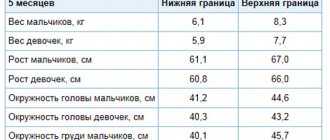What can a 5 month old baby do?
By this age, the baby is already independently rolling over from his back to his tummy and taking on positions that are comfortable for play. Learns to crawl, actively moves his arms and legs while lying on his stomach. Little by little he tries to sit up, leaning on his hand and trying to straighten his back.
The development of a child at 5 months allows him to independently pick up toys and hold them for a long time, studying them. Now the baby recognizes his mother and the people who are often with him. Able to distinguish the intonation of adults and tries to respond to them.
The baby really likes the songs, music and poems that mom tells. The first rudiments of character appear, for example, crying when a toy is taken away or put in bed. He is interested in adult food, reaches out for a taste; with such manifestations, it is worth thinking about introducing complementary foods.
How does a five month old baby communicate?
The baby’s psycho-emotional state allows him to experience many emotions: joy, fun, sadness and even anger. This manifests itself in violent reactions to surrounding phenomena. He laughs, screams loudly, smiles, gets angry. Depending on the situation, the intonation of babble and facial expression change. Speech becomes clearer for the baby, he understands more words and intonations.
Attachment to parents and close relatives increases. Children at this stage of life enjoy spending time with their family. There are a variety of reactions to strangers. Some babies are afraid of all strangers, crying and screaming when they pick them up. There are those who treat everyone differently, and even a mother cannot predict the reaction to a certain person. Occasionally, five-month-old babies have a positive attitude towards all strangers. In the presence of their mother, children, as a rule, behave more boldly; without her, they become more modest and timid. Some babies already know how to consciously attract attention to themselves by screaming or the noise of a rattle.
Most children develop object memory. For example, if you hide your favorite rattle, but leave part of it visible, the child will recognize it and immediately pull it out. Some toys become loved, some are disliked and rejected immediately after purchase or over time. The psyche of girls and boys at this time is similar, they behave approximately the same.
Helping a 5 month old baby develop
Mandatory activities with a child at 5 months, as before, remain gymnastics and physical exercises. This helps strengthen muscles and teaches the child to control his body. Spread your baby's arms apart, and then gently cross them over his chest. Raise your arms up and lift them a little, allowing your baby to sit down.
At the age of 5 months, a baby is given a massage not only with light stroking, but now with pinching, tapping and kneading.
Develop your baby's crawling ability. To do this, place the baby on his stomach and his favorite toy at a short distance. If the baby doesn't succeed, place your hand at his feet, thus allowing the baby to push away from you.
Communicate with your baby as much as possible. Tell him small stories, praise him, tell him how good he is. Thanks to this, the child will learn new words and learn intonation.
When communicating with the baby, freeze for a moment, let the baby be surprised and make you start talking to him again. Whisper in the baby's ear, because it is not only pleasant, but also teaches the child to listen.
Playing games
You can play “What Animals Say” with a 5-month-old child. If you have large cards or pictures with animals, show them to your baby, sounding out their voices. If you have a printer, these games are easy to make yourself. Start with simple animals that your baby can see on the street. For example, cat, dog, pigeons. The next time you go for a walk and see these animals, show them to your baby.
“What are the parts of the body called?” Sit in front of your baby and point with your finger at your body parts, for example: mouth, nose, eyes, arms, legs. After each name, point your finger at the same parts of the baby’s body.
What can my child already do at the age of 5 months?
At 5 months, your baby is getting better and better at expressing his emotions. He shows you his affection by caressing you, hugging you with his small arms or simply grabbing your hand, he reaches out to you asking you to hold him, and he may even laugh at your jokes. Sometimes you even seem to suspect: your baby understands how language and speech work, and most likely sometimes responds to his name. However, he will be able to do this consistently only after a couple of months. He also tries to sit and, as his hands become freer, he interacts with toys by banging them together, stacking them, or throwing them for you to fetch. When will my child be able to sit without support?
By this point, your child’s body has already become quite strong and developed - remember that he could four months ago, and now he is already trying to sit! If you sit your baby on the floor or on your lap, he or she can probably sit without support for several minutes.
Some children sit down earlier, some later, but before 5 months you should not sit the baby down, since the muscles and bones of the back are not yet strong enough for such a load. Most pediatricians are of the opinion that you need to look at the child - if he tries to sit up from 3 months, then at 5 it is quite possible to let him sit on his own or with a pillow under his back, but if he is lazy and prefers to lie down, then you should not rush him , it means he’s just not ready yet. If you want to speed up this process, place him on his stomach often to strengthen the muscles in his neck, back and shoulders.
To help your child sit more stable, spread his legs wider to form a triangle - this will help him maintain his balance better and be able to sit on his own longer. This means that he will be able to occupy himself for some time, and you will have an extra free minute! It would not be an exaggeration to say that this is a small holiday for a young mother.
Why does a child endlessly repeat the same sound?
Your child simply trains his articulatory apparatus, adding more and more new sounds to his active vocabulary. At this age, he really likes to make all the sounds that he can, so if he gets a new sound, he begins to repeat it endlessly in order, firstly, to consolidate success, and, secondly, to get pleasure from such an interesting classes. Even if this is a little annoying, be patient and remember that this is another step on the path to speech, because some children begin to speak before they are one year old!
How does my child see?
At this age, the child is increasingly able to distinguish small objects and small patterns, for example, on a carpet on the floor, so carefully ensure that all his toys are either non-separable or have such large parts that they cannot be swallowed. Well, of course, you shouldn’t forget about the cleanliness of the floors.
Your baby can already follow a small moving object with his eyes, for example, a fly flying around the room. In addition, the ability to logically connect the appearance of objects with what he remembers about them also develops. That is, he can recognize a toy, of which he sees only part, and understand that the rest is hidden under a cloth or something else. He will soon realize that an object can exist even if he does not see, hear or feel it at all (this is called the “idea of the permanence of objects”). This feature will pave the way for a variety of hide and seek games you'll play in the coming months.
Does the child recognize his name when I call him?
It is quite possible that your baby already recognizes his name when you say it in conversation with friends or when you say it from across the room. Take the time to sit down next to your baby and repeat his name while looking directly at him to help him connect the concept with the sounds. Your child at this age looks carefully at your mouth and often copies your articulation - be sure to give him this opportunity as often as possible, this will help him master speech. If he can repeat the sounds after you, he will understand where they come from and will begin to imitate all everyday sounds, such as a bell ringing, a window knocking, or a frying pan sizzling. Of course, he is unlikely to succeed, but he will begin to understand that there are different sources of sounds. At this age, all sorts of simple sounding toys will be very useful - not with buttons and screens, but rattles, drums and the like - so that he can see how he himself makes these noises.
If this doesn’t scare you, you can let him rattle pots and spoons, but this will most likely happen a little later, when he can confidently sit or even crawl.
Can my child express affection towards me?
Up to this point, your child could only show anger, disagreement, boredom or joy. Now, at 5 months, he is little by little learning to express the feelings he feels for his mom and dad - love, affection and even a sense of humor.
Most often, children express affection for their mother by stretching out their hands in her direction, although this does not always mean that they want to be held. The child may pet you lightly - or try to - and laugh with joy that you are nearby and laughing with him.
From 5 months there comes an amazing time when your baby is happy with you, and you can make him laugh with a simple grimace, funny sounds, and imitating different animals.
Enjoy every minute!
How to teach a child to sit
Let's say that by the age of six months the baby does not sit independently, do not be afraid - his spine has not yet become stronger. But if he doesn’t sit down even by eight months, he will need help. Here are exercises that are sure to help your child learn to sit.
- Place the baby on his back, then pull him forward by both arms to sit down, and then, after holding for a few seconds, release him. You can lift with both hands in turn, making sure that he tries to sit on his own.
- Sit the baby with his back to you and support his elbows with his hands, put toys around him so that he has something to reach for.
- Place the child in front of you and, holding him by the arms, rock him to the sides.
When deciding how to teach a child to sit, try sitting him on the floor, spreading his legs and resting his hands on the floor. Or place your baby in a highchair. At how many months a child begins to sit is an individual question, and only if by 9 months he still has not learned to sit, you can consult a doctor. If a baby at this age does not try to sit up, this may be a deviation from normal norms.
How to help your baby and speed up the process of learning new movements?
The main emphasis when choosing exercises should be aimed at strengthening the back muscles . Since very soon the baby will begin to crawl and sit up, the main load will be on this muscle group.
- Crawling. Well, this is not full crawling yet, but rather crawling, but this is already an important step forward. To encourage your baby to crawl, place various toys around him. He will try to reach them with his handle and, accordingly, will be forced to crawl closer.
- Massage becomes a little more complicated by five months. Now calm stroking and rubbing is not enough; a little more effort is required. Pinch and knead your baby’s muscles, don’t be afraid to apply light pressure on the area being kneaded. Just remember that during this procedure the baby should not experience negative emotions. Everything should be organized so that he is as comfortable as possible.
- The baby still needs to be carried. Let him touch previously inaccessible objects, let him try them out too. Don't forget to accompany all your actions with explanatory comments.
- Now the mother has the opportunity to leave the baby alone in the playpen or crib for a few minutes, since he is quite capable of entertaining himself on his own. Just don’t abuse this, otherwise the baby may think that he was abandoned, and then hysteria cannot be avoided.
We recommend that you read: What a baby should be able to do at 2 months











